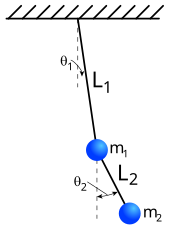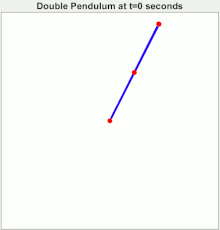Double pendulum

In physics and mathematics, in the area of dynamical systems, a double pendulum also known as a chaotic pendulum is a pendulum with another pendulum attached to its end, forming a simple physical system that exhibits rich dynamic behavior with a strong sensitivity to initial conditions.[1] The motion of a double pendulum is governed by a set of coupled ordinary differential equations and is chaotic.
Analysis and interpretation
Several variants of the double pendulum may be considered; the two limbs may be of equal or unequal lengths and masses, they may be simple pendulums or compound pendulums (also called complex pendulums) and the motion may be in three dimensions or restricted to the vertical plane. In the following analysis, the limbs are taken to be identical compound pendulums of length l and mass m, and the motion is restricted to two dimensions.


In a compound pendulum, the mass is distributed along its length. If the double pendulum mass is evenly distributed, then the center of mass of each limb is at its midpoint, and the limb has a moment of inertia of I = 1/12ml2 about that point.
It is convenient to use the angles between each limb and the vertical as the generalized coordinates defining the configuration of the system. These angles are denoted θ1 and θ2. The position of the center of mass of each rod may be written in terms of these two coordinates. If the origin of the Cartesian coordinate system is taken to be at the point of suspension of the first pendulum, then the center of mass of this pendulum is at:
and the center of mass of the second pendulum is at
This is enough information to write out the Lagrangian.
Lagrangian
The Lagrangian is
The first term is the linear kinetic energy of the center of mass of the bodies and the second term is the rotational kinetic energy around the center of mass of each rod. The last term is the potential energy of the bodies in a uniform gravitational field. The dot-notation indicates the time derivative of the variable in question.
Since (see Chain Rule and List of trigonometric identities)
and
substituting the coordinates above and rearranging the equation gives
The Euler-Lagrange equations then give the two following second-order, non-linear differential equations in [a]:
No closed form solutions for θ1 and θ2 as functions of time are known, therefore solving the system can only be done numerically, using the Runge Kutta method or similar techniques.

Chaotic motion


The double pendulum undergoes chaotic motion, and cleary shows a sensitive dependence on initial conditions. The image to the right shows the amount of elapsed time before the pendulum flips over, as a function of initial position when released at rest. Here, the initial value of θ1 ranges along the x-direction from −3.14 to 3.14. The initial value θ2 ranges along the y-direction, from −3.14 to 3.14. The colour of each pixel indicates whether either pendulum flips within:
- (black)
- (red)
- (green)
- (blue) or
- (purple).

Initial conditions that do not lead to a flip within are plotted white.
The boundary of the central white region is defined in part by energy conservation with the following curve:
Within the region thats defined by this curve, that is if
then it is energetically impossible for either pendulum to flip. Outside this region, the pendulum can flip, but it is a complex question to determine when it will flip. Similar behavior is observed for a double pendulum composed of two point masses rather than two rods with distributed mass.[2]
The lack of a natural excitation frequency has led to the use of double pendulum systems in seismic resistance designs in buildings, where the building itself is the primary inverted pendulum, and a secondary mass is connected to complete the double pendulum.
See also
- Double inverted pendulum
- Pendulum (mechanics)
- Trebuchet
- Bolas
- Mass damper
- Mid-20th century physics textbooks use the term "double pendulum" to mean a single bob suspended from a string which is in turn suspended from a V-shaped string. This type of pendulum, which produces Lissajous curves, is now referred to as a Blackburn pendulum.
Notes
- ^ The equations were obtained with the following Mathematica code:
Block[ {m, g, \[Theta], l, L, x, y, v, t}, x = Accumulate[{Subscript[l, 1], Subscript[l, 2]}* Sin[{Subscript[\[Theta], 1], Subscript[\[Theta], 2]}]]; y = Accumulate[ {Subscript[l, 1], Subscript[l, 2]}*-Cos[{Subscript[\[Theta], 1], Subscript[\[Theta], 2]}]]; v = D[{x, y} /. Subscript[\[Theta], i_] :> Subscript[\[Theta], i][t], t]; L = Plus @@ ({Subscript[m, 1], Subscript[m, 2]}*(1/2 Map[# . # &, Transpose[v]] - ( g y /. Subscript[\[Theta], i_] :> Subscript[\[Theta], i][t]))); FullSimplify[ Table[ D[ Construct[ Function, L /. Subscript[\[Theta], i]'[t] -> # ]'[Subscript[\[Theta], i]'[t]], t ] == Construct[ Function, L /. Subscript[\[Theta], i][t] -> # ]'[Subscript[\[Theta], i][t]] , {i, 2} ], Assumptions -> { Subscript[l, 1] > 0, Subscript[l, 2] > 0, Subscript[m, 1] > 0, Subscript[m, 2] > 0 } ] /. h_[t] :> h // Column // TeXForm ]
References
- ^ Levien, R. B.; Tan, S. M. (1993). "Double Pendulum: An experiment in chaos". American Journal of Physics. 61 (11): 1038. Bibcode:1993AmJPh..61.1038L. doi:10.1119/1.17335.
- ^ Alex Small, Sample Final Project: One Signature of Chaos in the Double Pendulum, (2013). A report produced as an example for students. Includes a derivation of the equations of motion, and a comparison between the double pendulum with 2 point masses and the double pendulum with 2 rods.
- Meirovitch, Leonard (1986). Elements of Vibration Analysis (2nd ed.). McGraw-Hill Science/Engineering/Math. ISBN 0-07-041342-8.
- Eric W. Weisstein, Double pendulum (2005), ScienceWorld (contains details of the complicated equations involved) and "Double Pendulum" by Rob Morris, Wolfram Demonstrations Project, 2007 (animations of those equations).
- Peter Lynch, Double Pendulum, (2001). (Java applet simulation.)
- Northwestern University, Double Pendulum Archived 2007-06-03 at the Wayback Machine, (Java applet simulation.)
- Theoretical High-Energy Astrophysics Group at UBC, Double pendulum, (2005).
External links
- Animations and explanations of a double pendulum and a physical double pendulum (two square plates) by Mike Wheatland (Univ. Sydney)
- Interactive Open Source Physics JavaScript simulation with detailed equations double pendulum
- Interactive Javascript simulation of a double pendulum
- Double pendulum physics simulation from www.myphysicslab.com using open source JavaScript code
- Simulation, equations and explanation of Rott's pendulum
- Comparison videos of a double pendulum with the same initial starting conditions on YouTube
- Double Pendulum Simulator - An open source simulator written in C++ using the Qt toolkit.
- Online Java simulator Archived 2022-08-16 at the Wayback Machine of the Imaginary exhibition.
- v
- t
- e


branches
maps (list)
systems
theorists
- Michael Berry
- Rufus Bowen
- Mary Cartwright
- Chen Guanrong
- Leon O. Chua
- Mitchell Feigenbaum
- Peter Grassberger
- Celso Grebogi
- Martin Gutzwiller
- Brosl Hasslacher
- Michel Hénon
- Svetlana Jitomirskaya
- Bryna Kra
- Edward Norton Lorenz
- Aleksandr Lyapunov
- Benoît Mandelbrot
- Hee Oh
- Edward Ott
- Henri Poincaré
- Itamar Procaccia
- Mary Rees
- Otto Rössler
- David Ruelle
- Caroline Series
- Yakov Sinai
- Oleksandr Mykolayovych Sharkovsky
- Nina Snaith
- Floris Takens
- Audrey Terras
- Mary Tsingou
- Marcelo Viana
- Amie Wilkinson
- James A. Yorke
- Lai-Sang Young
articles
































